
Electronic Music for Commercial Radio and TV Spots
Hale Smith is a black American composer who had a day job at Sam Fox Film Rights, publisher of background music for commercials. In 1968 Hale asked his friend Donald Erb to compose some electronic music for Sam Fox’s library. Don was not interested but passed along Hale’s request to me. I went to New York, met Hale, and learned that the most successful music was the easiest to use: tailored to precise 30- or 60-second durations and containing “little holes” for ease of editing. He told me that this library was known as “needle-drop” music, because it was charged at a flat rate per drop of the turntable needle onto the LP disk (i.e., for use in one commercial) without further royalties no matter how often the commercial was broadcast. It was also low-budget music, the fees ranging from around $7.50 to $45.00 (I would be paid 50%). It was directed towards the very large market of recording studios and radio stations that wanted hassle-free stock music for simple local commercial spots, without having to hire a composer. Sam Fox was a long-established company and their earliest libraries were issued on 78 rpm records. Now they were engaged in publishing two libraries of 33 1/3 rpm LP disks, Sam Fox for ASCAP music and Demeter for BMI music. Hale said that most of their music came from scores for films that had been produced but then encountered problems and were never released. Sam Fox wanted to release some electronic music, which was then in the public eye, but at that time there were no distressed films with electronic scores available.
Working for a few weeks in the R.A. Moog Co. studio in Trumansburg, I composed enough music for both sides of an LP disk, and gave the tunes suitably dopey titles (some of which were changed to dopier ones by Sam Fox Film Rights). The disk was released in 1968 with the title “Electronic Effects” shortly before I moved to Cleveland. In mid-1969 I began to hear my music on local TV commercials, so I hooked up a tape recorder to my TV. I used an old low-end half-track Webcor recorder (a prize for playing the opening to “Rhapsody in Blue” and winning the Michigan division of the “Music Man” contest in 1960) at 3 ¾ ips; I sought only basic recording quality, just to prove the use of my music if necessary.
"Earth-to-Moon Discovery Kit"
Detroit Area Pontiac Dealers
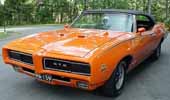
Every Pontiac showroom has beautiful cars and great deals. And right now, your Detroit area Pontiac dealers have something extra special for you, an Earth to Moon Discovery Kit. It's worth over 5 dollars; it’s yours for 50 cents! It includes full-color maps of the Universe, the Moon, plus a 65-page pictorial booklet. Stop by your Pontiac dealer's today. When he promises you the Moon, he means it!
PLAYER FOR MP3 AUDIO FILE
(Note: This track has a severe hum)
Duration :30 -- Recorded June 1969.
This first use, of Sam Fox SF1020A “Solar Song #3,” presaged the popularity of this tune, which was also used by TV Guide magazine.
"A Child Is Not a Rat"
TV Guide

TV Guide’s continuing report on TV and your child. Psychologists may understand how animals learn. But applying this knowledge to humans is not easy. Don’t miss “A Child Is Not a Rat” in the new issue of TV Guide.
PLAYER FOR MP3 AUDIO FILE
Duration :20 -- Recorded November 1969.
Music: Sam Fox SF1020A "Solar Song #3”
Although the needle-drop fees paid by TV Guide to Sam Fox Film Rights were insignificant, broadcasting these commercials on national TV generated royalties from ASCAP, for Sam Fox and for me. One of the staff at Sam Fox later told me that this commercial made them more money than the royalties from “Man of La Mancha.” TV Guide used my music weekly, almost non-stop, from 1969 to 1981. The royalties put me through college.
"A New Communications System"
Ohio Bell
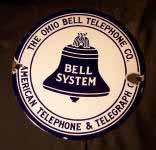
These are the sounds of a new communications system coming to life. To be run by rooms full of electronic switching equipment -- guided and checked by an electronic brain. Ohio Bell technicians are building and delivering it now -- the electronic telephone network of the future. Someday you'll dial frequently called numbers with just two or three digits. You'll be able to dial your own three-way conversations. And when you leave home, your telephone calls will follow you across town, to the phone near you. City by city, area by area, Ohio Bell technicians will be bringing you the electronic telephone system of the future. They're just some of the people who prove every day: there's more to Ohio Bell than meets the ear.
PLAYER FOR MP3 AUDIO FILE
Duration :60 -- Recorded August 1970.
Composed for Ohio Bell. As my Sam Fox music circulated around town, I picked up a few music-composing jobs – this was the first.
"Three New Gasolines with Less Lead"
Sohio

Let’s go get some gas!
Dad, let’s get a gasoline with less lead! It says on TV Sohio has one for every car.
Well, we’ll see, son—but this big engine needs a high-octane gasoline.
Why sure, we’ve got a reduced-lead gasoline for your car—Boron! No change in octane, best additives, plus the same as premium.
That's just what they say on TV!
Sohio makes three new gasolines with less lead—one is just right for your car.
PLAYER FOR MP3 AUDIO FILE
Duration :30 -- Recorded April 18, 1971.
Music: Sam Fox SF1025B “Solar Seasoning” (#1 of 7)
"Makes Everything Rinse-Agent Spotless"
Dishwasher All
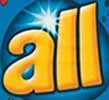
Oh, I see you have a built-in oven, a built-in range, and a built-in dishwasher!
Uh-oh. Water spots!
What you need is Dishwasher All with its own built-in rinse agent that helps get rid of ugly water spots. You don’t have to add a separate rinse agent to get dishes, glasses, everything rinse-agent spotless.
Dishwasher All’s built into my kitchen to stay!
Makes everything rinse-agent spotless!
PLAYER FOR MP3 AUDIO FILE
Duration :30 -- Recorded November 7, 1971.
Music: Sam Fox SF1025B “Solar Seasoning” (#5 of 7)
"Each One Is a Little Different"
Zappone's Restaurants
Where would you like to have dinner tonight, hon?
Mmm, how about one of Zappone’s restaurants?
Well, we like Zappone’s Thirteen Colony.
Let’s try the Olive and Grape.
Or, how about, uh, the Heritage House? Or, or Boston Heights?
Uhhh, maybe Zappone’s 1880’s is more like it tonight. Or Zappone’s The Forty-Niner. Or Zappone’s....
That's what's nice about Zappone's restaurants. Each one is a little different. Distinctive in decor—in daily specialties, too. What's the same is the Zappone name. And that stands for consistently fine quality food, friendly service, and prices that are moderate. So decide on a Zappone's restaurant for lunch or dinner. No matter which one you decide on, you'll find it deliciously different from every other Zappone's. And every other res—
Well, now that we decided on the Zappone restaurant, shall I wear the blue dress or the gray one?
I like the red one. But the pink one is....
Zappone's. We make dining out a special occasion.
PLAYER FOR MP3 AUDIO FILE
Duration :60 -- Recorded February 1972.
Composed for Zappone’s. A typical low-budget local commercial: pedestrian writing with a feeble attempt at domestic drama.
"Valentine's Any Day This Week"
Zappone's Restaurants
For sweethearts who can’t remember special days, Zappone’s restaurants hereby proclaim this week to be Valentine’s Day. Every day this week, you can enjoy a romantic sweetheart dinner for two, starting with the Cupid’s fruit cup and ending with a sweetheart parfait. In between, there'll be Zappone's special roast tenderloin of beef with all the accompaniments—red wine, soft lights, and Zappone's always-special service. Just in case, Zappone’s will have a do-it-yourself Valentine, all ready for you to sign. So forget about remembering special days. Celebrate Valentine's Day at Zappone's any day this week—or if you insist, on Monday, February 14th.
Zappone's. We make dining out a special occasion.
PLAYER FOR MP3 AUDIO FILE
Duration :60 -- Recorded February 1972.
Composed for Zappone’s. An inspired marketing idea, to lure Cleveland-area players and three-timers to take care of all their women one-by-one at Zappone’s. Even to the point of providing them with a handy Valentine’s Day card in case of a last-minute change! Could this scheme have been more dazzlingly pragmatic? Do you suppose any of the women who heard this spot and had Valentine's dinner at Zappone's started wondering...?
"Don't Worry"
Sears Optical

I’ve just got to get it done today. Oh, I hope I can find a parking space.
Don't worry.
I don’t even have an appointment!
Don't worry!
I wonder how I’ll look in glasses?
Don't worry.
Dan and Cindy need glasses too—boy, I hope I can afford it.
Don't worry—you're at the Optical Department at Sears. Don't worry!
Contact lenses available now at most Optical Departments at Sears.
PLAYER FOR MP3 AUDIO FILE
Duration :30 -- Recorded March 30, 1972.
Music: Sam Fox SF1020B “Moondust Dance #2.”
"Soulman"
The Houlihan and Big Chuck Show
WJW-TV Channel 8
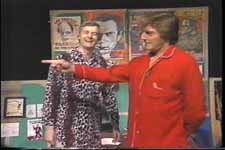
The feared crime fighter flies the hapless citizen not to his job across town, but to Cuba.
PLAYER FOR MP3 AUDIO FILE
Duration 3:20 -- Recorded May 19, 1973.
This was a late-movie show interspersed with comedy skits.
Music (at 1:01-1:05) Sam Fox SF1020A “Solar Song #2.”
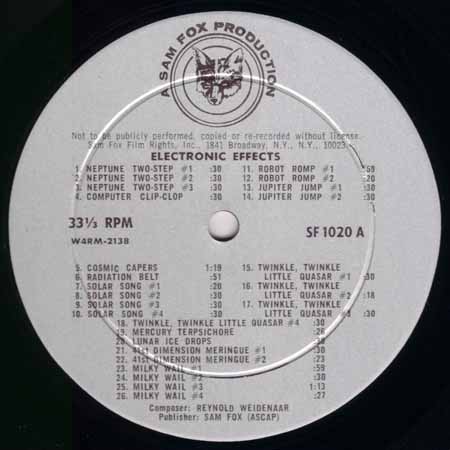
8. SOLAR SONG #2
"ELECTRONIC EFFECTS" -- SF1020 RELEASED 1968
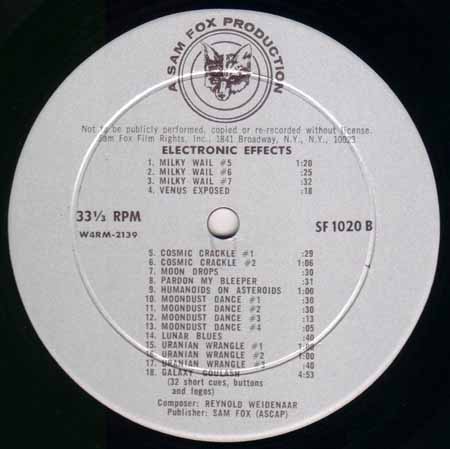
My second production for Sam Fox was one side of an LP in late 1970. I was then working full-time at Audio Recording Studios, Inc., and also using the electronic music studio at the Cleveland Institute of Music while taking composition lessons there from Donald Erb. I recorded the synth parts at CIM on an Ampex 300 4-track recorder. The drum parts were later overdubbed at ARS and were performed by George Stage, a recording engineer at the studio (cuts 1, 2, 3, 4, 5, 8, 10, 11).
Working as a recording engineer in a studio which had purchased the Sam Fox Library gave me an insight into how the royalty process worked (or didn't work, to be more precise). ARS subscribed to the Sam Fox Library by paying a fee for each disk and also a basic yearly usage fee. ARS would then bill clients a needle-drop fee (per-use synchronization) when a Sam Fox tune was recorded on a commercial or some other soundtrack, typically $25. ARS was then supposed to file a form with Sam Fox, showing which music had been used and paying a scheduled per-use license fee, typically $7.50-$15--half of which was then to be reported and paid by Sam Fox to the composer. When I started working as Traffic Manager at ARS in April 1969, I saw that the required forms were not going out to Sam Fox. Naturally in my new position of responsibility I was able to rectify this little oversight. My colleagues and the owners at ARS were very supportive of this new policy; the money was minimal and they were happy that someone other than them was taking care of the paperwork.
The number of forms from ARS citing my music could not have been more than six or eight over the course of the year. For any one composer it is a high-volume business only when his or her music is widely used and faithfully reported at recording studios and radio stations all across the country. This proved to be unlikely. By mid-1970, a year's worth of royalty statements from Sam Fox to me showed precisely NONE of the needle-drops reported to them by ARS. The nice folks at Sam Fox had the good sense to be embarrassed by this and managed to "find" some hundreds of dollars in missing royalties. However, without a way to research uses of my music in local markets around the U.S., most such uses probably escaped royalty payments to the composer.
The use of music in national TV commercials, however, was another matter entirely. ASCAP monitored the broadcasts of TV Guide and other commercials, and paid royalties to Sam Fox and to me. Needle-drop fees in this context were insignificant.
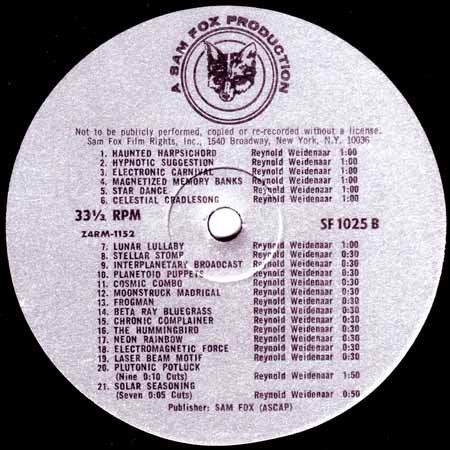
11. COSMIC COMBO
NO TITLE -- SF1025B RELEASED 1970
Cut 20 "Plutonic Potluck" no. 2 of 9 might be more accurately titled "The Day the Moog Sequencer Died." A tape recorder just happened to be running and captured this equipment failure.
THe third and final production for Sam Fox was released in 1973. FOr the first time it was dignified by a printed cover, in color! My friend and colleague David Peelle collaborated with me on this project. By this time there were hundreds of electronic-music studios, thousands of composers, and millions of MiniMoogs, so the competition was fierce. There were just a few brief uses reported by the ASCAP survey and Sam Fox.
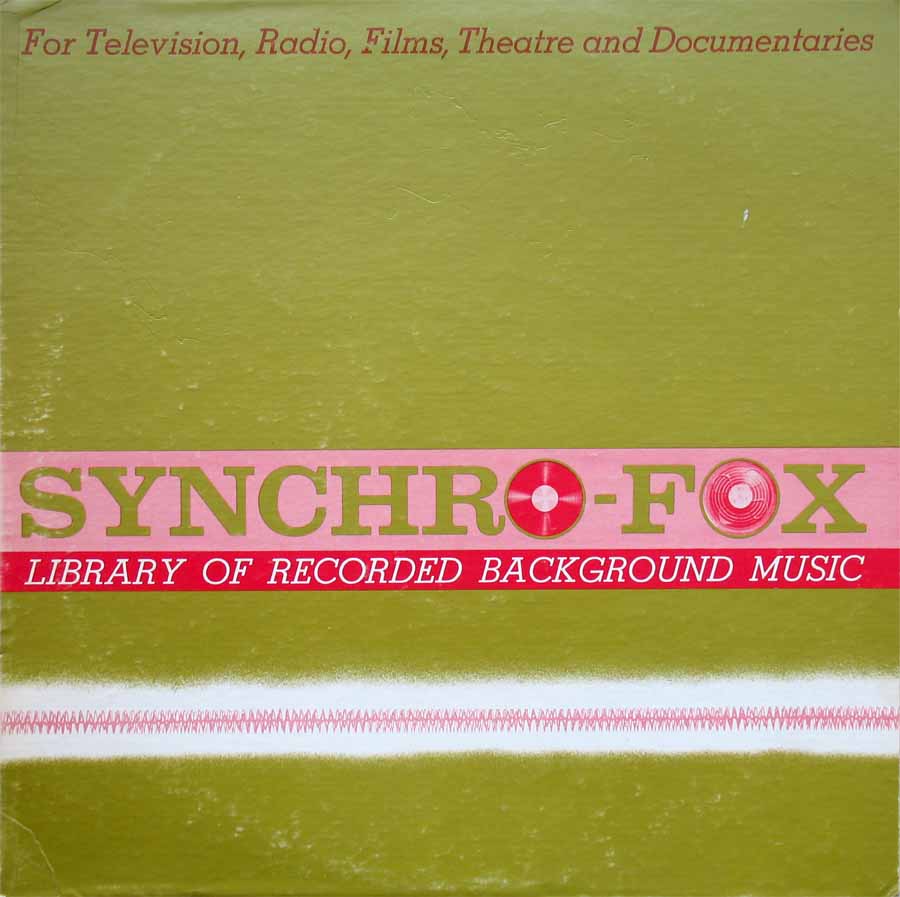
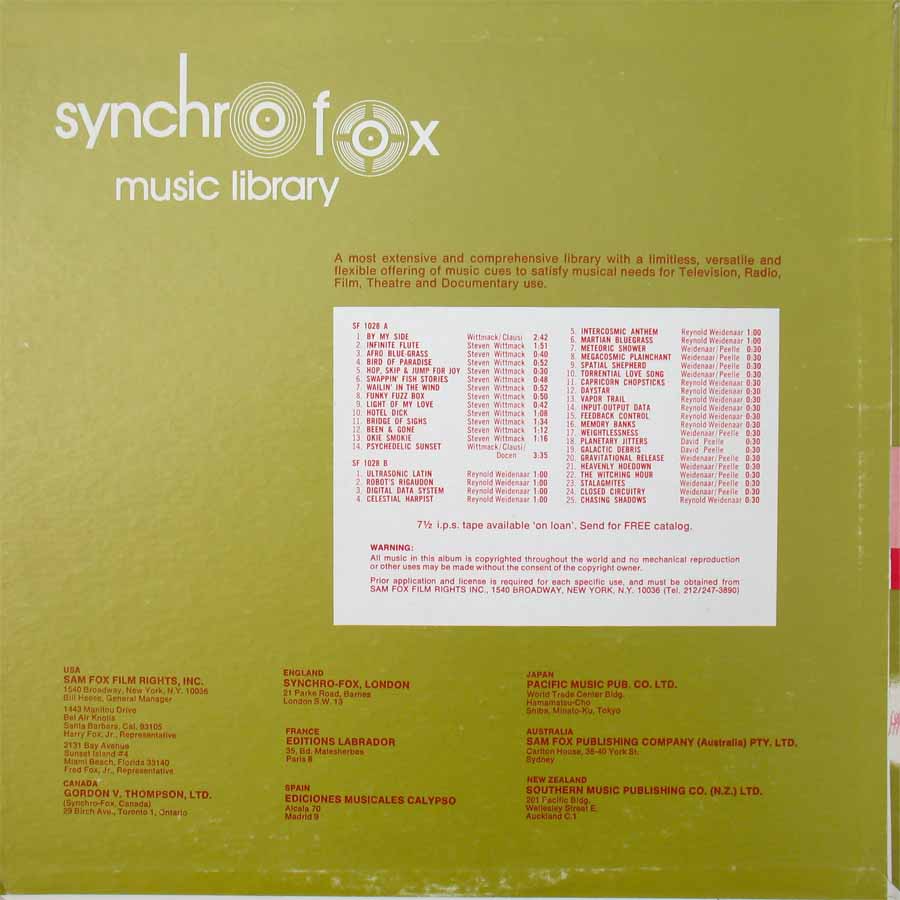
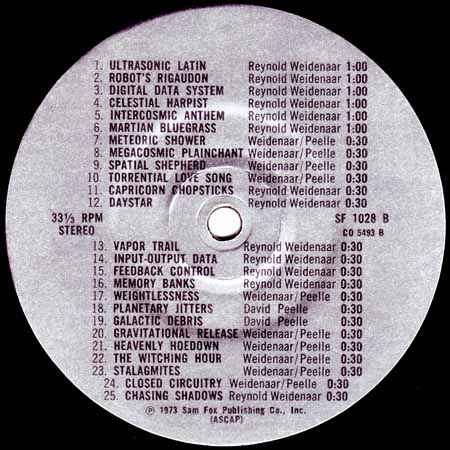
NO TITLE -- SF1028B RELEASED 1973